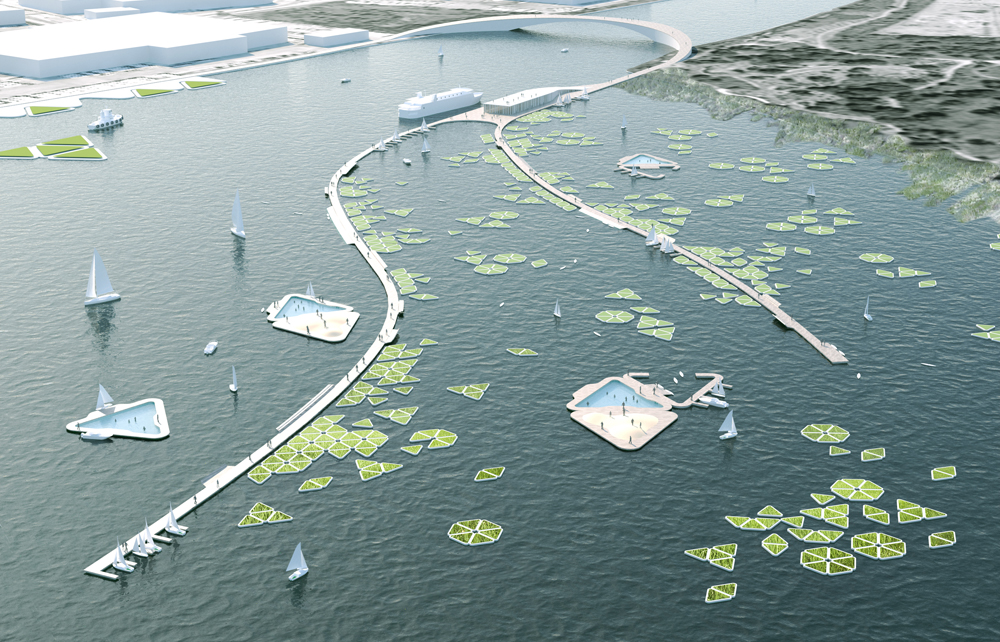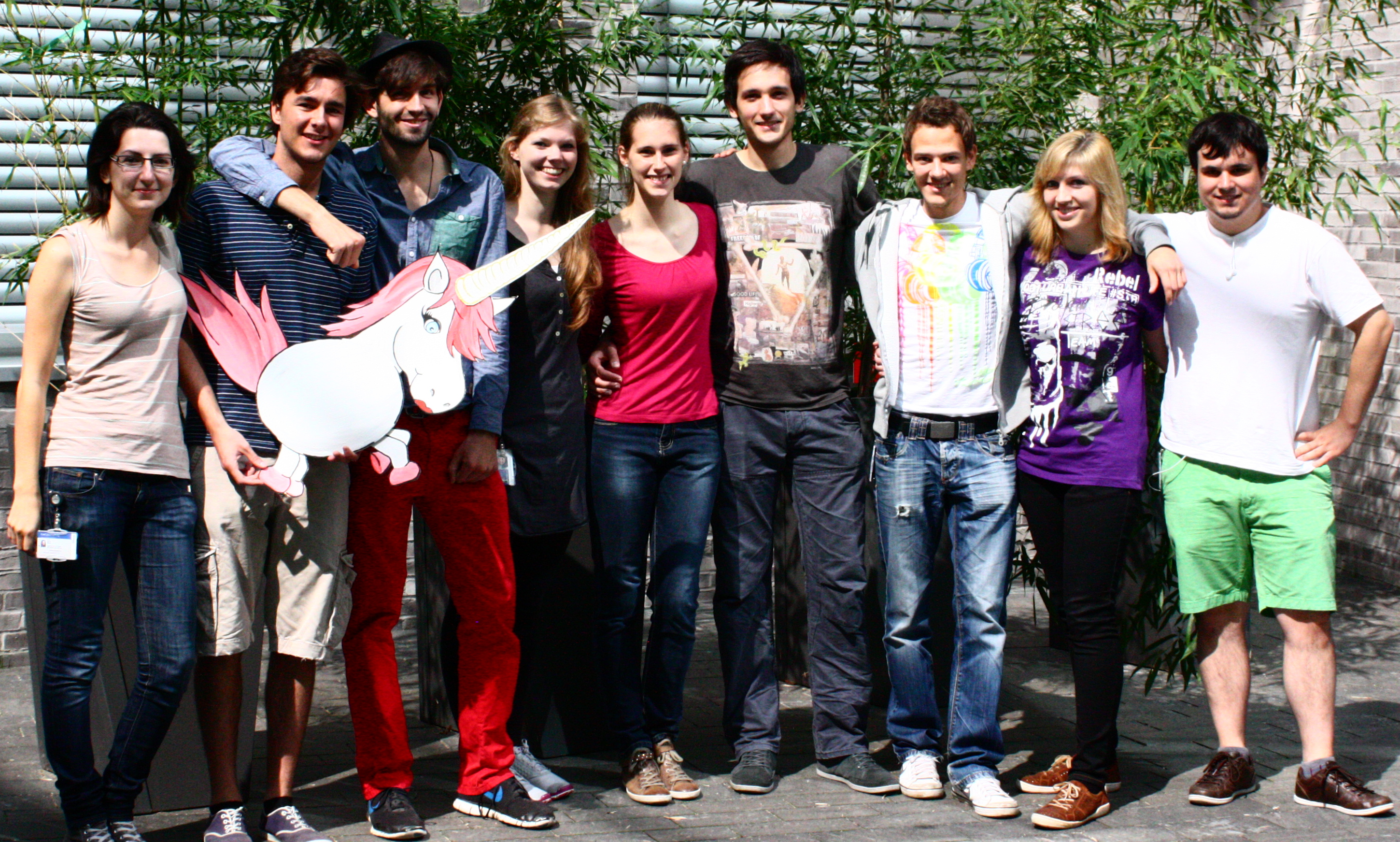Team:TU-Munich/Team/Collaborations
From 2013.igem.org
m (→Visiting Freiburg iGEM team 2013) |
(→Collaboration with Op.N) |
||
| (35 intermediate revisions not shown) | |||
| Line 6: | Line 6: | ||
<!-- Start des Inhalts --> | <!-- Start des Inhalts --> | ||
| - | ==Collaboration with | + | ==Collaboration with Dundee iGEM team 2013== |
| - | + | ||
| - | + | [[File:TUM13_Collaboration_Dundee.png|thumb|right|350px|'''Figure 1:''' Shipment from the Dundee 2013 iGEM team.]] | |
| + | The [https://2013.igem.org/Team:Dundee Dundee] iGEM team 2013 also works on bioremediation: The toxin microcystin is released into water from lysed cyanobacteria and appears in great amounts during algal blooms. This cyclic peptide toxin covalently binds the protein phosphatase type 1 (PP1) and is thereby toxic for mammals. The idea of the Dundee iGEM team is to express the PP1 protein as an absorber for microcystin. We received their PP1 BioBrick, converted it from <nowiki>RFC 10 to RFC 25</nowiki> and constructed some expression plasmids to transform ''Physcomitrella patens''. Our purpose was applying Dundee's molecular mop in an aquatic, photoautotrophic chassis and thus expand their project's to a wider range. We successfully obtained equipped the moss plants with our synthetic moss receptor and extracellular PP1. '''Please visit our [https://2013.igem.org/Team:TU-Munich/Results/GM-Moss PhyscoFilter] results page to read more about this great collaboration.'''<br> | ||
| + | We'd also like to congratulate the Dundee iGEM team 2013 for their success at the European Jamboree: '''Well done Scots!''' | ||
| - | < | + | ==Collaboration with Glowing Plants== |
| + | [[File:TUM13_Glowing_idea.png|thumb|left|300px|'''Figure 2:''' Outline of idea to utilise transgenic moss as ambient light source.]] | ||
| + | [[File:TUM13_Blubber_flasks.gif|thumb|right|700px|'''Figure 3:''' Bubbling flask with our moss. This is how the moss would circulate in the bubble column reactor.]] | ||
| + | We contacted the [http://glowingplant.com/ Glowing Plant] Team which has set itself the goal to develop glowing transgenic ''A. thaliana'' plants using luciferase based on the work of [https://2010.igem.org/Team:Cambridge iGEM Cambridge 2010]. They were quite interested in our idea using transgenic moss plants as light source and we agreed on a meeting on October 25<sup>th</sup>. Ahead of the European Jamboree (October 7 <sup>th</sup> they have also posted our project video on their [http://glowingplant.com/ blog] in order to promote it. We would love to see glowing ''Physcomitrella'' plants in the future. | ||
| - | + | Glowingplant performed an extremely successful kickstarter campaign to raise money for their idea of plants which gather energy by photosynthesis and emit it again later by bioluminescence. | |
| - | + | On the 25<sup>th</sup> of October we had the great chance to meet [http://glowingplant.com/team Antony Evans] of the [http://glowingplant.com/ glowingplant team] on his visit to Europe. After having talked about the current status of our projects we had a great knowledge exchange about legal regulations, the public opinion on transgenic plants in Europe and in the US as well as about the potential sizes of the market for transgenic plants for home use. We intend to intensify our collaboration in the fashion of testing their gen cassette used for the luciferase reaction in our moss. It would be interesting to check how the utilized promoters for A. thaliana work in our moss ''P. patens''. However we plan to build a new gene construct using our tested Actin 5 promotor from ''Physcomitrella''. | |
| - | + | Maybe one day our moss will be usable to enlighten our living environment in aerated lava lamps like the one shown in figure 2. Having explored the scientific opportunities of our moss for this purpose glowingplant could become an extremely valuable partner on the way to a commercial product. | |
| - | + | ||
| - | + | ||
| - | + | ||
| - | + | ||
==Collaboration with Paris-Saclay iGEM team 2013== | ==Collaboration with Paris-Saclay iGEM team 2013== | ||
[[File:TUM13_Collaboration_Paris.jpg|thumb|right|left|350px|'''Figure 4:''' Screenshot from our Skype conference with the Paris Saclay team.]] | [[File:TUM13_Collaboration_Paris.jpg|thumb|right|left|350px|'''Figure 4:''' Screenshot from our Skype conference with the Paris Saclay team.]] | ||
| - | The [https://2013.igem.org/Team:Paris_Saclay Paris_Saclay] iGEM team is working on the detection and degradation of [http://en.wikipedia.org/wiki/Polychlorinated_biphenyl polychlorinated biphenyl] (PCB) in the context of bioremediation. We arranged a | + | The [https://2013.igem.org/Team:Paris_Saclay Paris_Saclay] iGEM team is working on the detection and degradation of [http://en.wikipedia.org/wiki/Polychlorinated_biphenyl polychlorinated biphenyl] (PCB) in the context of bioremediation. We arranged a Skype-meeting, presented our projects to each other and agreed to '''exchange''' some of our coded '''BioBricks'''. The goal of that exchange was to test the new BioBricks in different chassis. |
==Collaboration with Op.N== | ==Collaboration with Op.N== | ||
| + | [[File:TUM13_Collaboration_OpN.jpg|thumb|left|350px|'''Figure 5:''' An architects vision of our remediation rafts]] | ||
| + | When we wondered how a moss filter could be implemented, we came across the NY PARALLEL NETWORKS concept which was designed by Op.N (Ali Fard and Ghazal Jafari). [http://op-n.net/filter/office/About-Op-N Op.N's work] considers "critical junction of architecture, landscape, and urban processes". The design and research practice is based in Cambridge and Toronto. Ali Fard and Ghazal Jafari are researchers at Harvard Graduate School of Design. | ||
| - | + | We got in touch via E-Mail and found Ali and Ghazal interested in our ideas and '''willing to allow''' us the '''usage''' of their '''image material''' used at the ONE PRIZE competition. | |
| - | + | ||
| - | We got in touch via E-Mail and found Ali and Ghazal interested in our ideas and willing to allow us the usage of their image material used at the ONE PRIZE competition. | + | |
==Visiting Freiburg iGEM team 2013== | ==Visiting Freiburg iGEM team 2013== | ||
| - | [[File:Muenchen-Freiburg-2013.jpg|thumb|left|350px|'''Figure | + | [[File:Muenchen-Freiburg-2013.jpg|thumb|left|350px|'''Figure 6:''' iGEM Teams Freiburg and Munich joint during our first visit]] |
| - | [[File:TUM13_Freiburg.JPG|thumb|right|200px|'''Figure | + | [[File:TUM13_Freiburg.JPG|thumb|right|200px|'''Figure 7:''' Our second visit]] |
During our [https://2013.igem.org/Team:TU-Munich/Results/GM-Moss#Trips_to_Freiburg trip to Freiburg] on August30<sup>th</sup> we met the iGEM team of Freiburg 2013. Along with a guidance through their lab and the Signalhaus they organized a city tour for us. This day ended with a barbecue together with the iGEM team. At this point we would like to thank you for your hospitality! | During our [https://2013.igem.org/Team:TU-Munich/Results/GM-Moss#Trips_to_Freiburg trip to Freiburg] on August30<sup>th</sup> we met the iGEM team of Freiburg 2013. Along with a guidance through their lab and the Signalhaus they organized a city tour for us. This day ended with a barbecue together with the iGEM team. At this point we would like to thank you for your hospitality! | ||
| - | |||
| - | |||
| - | |||
== Exchange of urgently needed BioBricks == | == Exchange of urgently needed BioBricks == | ||
Latest revision as of 03:42, 29 October 2013
Collaboration with Dundee iGEM team 2013
The Dundee iGEM team 2013 also works on bioremediation: The toxin microcystin is released into water from lysed cyanobacteria and appears in great amounts during algal blooms. This cyclic peptide toxin covalently binds the protein phosphatase type 1 (PP1) and is thereby toxic for mammals. The idea of the Dundee iGEM team is to express the PP1 protein as an absorber for microcystin. We received their PP1 BioBrick, converted it from RFC 10 to RFC 25 and constructed some expression plasmids to transform Physcomitrella patens. Our purpose was applying Dundee's molecular mop in an aquatic, photoautotrophic chassis and thus expand their project's to a wider range. We successfully obtained equipped the moss plants with our synthetic moss receptor and extracellular PP1. Please visit our PhyscoFilter results page to read more about this great collaboration.
We'd also like to congratulate the Dundee iGEM team 2013 for their success at the European Jamboree: Well done Scots!
Collaboration with Glowing Plants
We contacted the [http://glowingplant.com/ Glowing Plant] Team which has set itself the goal to develop glowing transgenic A. thaliana plants using luciferase based on the work of iGEM Cambridge 2010. They were quite interested in our idea using transgenic moss plants as light source and we agreed on a meeting on October 25th. Ahead of the European Jamboree (October 7 th they have also posted our project video on their [http://glowingplant.com/ blog] in order to promote it. We would love to see glowing Physcomitrella plants in the future.
Glowingplant performed an extremely successful kickstarter campaign to raise money for their idea of plants which gather energy by photosynthesis and emit it again later by bioluminescence.
On the 25th of October we had the great chance to meet [http://glowingplant.com/team Antony Evans] of the [http://glowingplant.com/ glowingplant team] on his visit to Europe. After having talked about the current status of our projects we had a great knowledge exchange about legal regulations, the public opinion on transgenic plants in Europe and in the US as well as about the potential sizes of the market for transgenic plants for home use. We intend to intensify our collaboration in the fashion of testing their gen cassette used for the luciferase reaction in our moss. It would be interesting to check how the utilized promoters for A. thaliana work in our moss P. patens. However we plan to build a new gene construct using our tested Actin 5 promotor from Physcomitrella.
Maybe one day our moss will be usable to enlighten our living environment in aerated lava lamps like the one shown in figure 2. Having explored the scientific opportunities of our moss for this purpose glowingplant could become an extremely valuable partner on the way to a commercial product.
Collaboration with Paris-Saclay iGEM team 2013
The Paris_Saclay iGEM team is working on the detection and degradation of [http://en.wikipedia.org/wiki/Polychlorinated_biphenyl polychlorinated biphenyl] (PCB) in the context of bioremediation. We arranged a Skype-meeting, presented our projects to each other and agreed to exchange some of our coded BioBricks. The goal of that exchange was to test the new BioBricks in different chassis.
Collaboration with Op.N
When we wondered how a moss filter could be implemented, we came across the NY PARALLEL NETWORKS concept which was designed by Op.N (Ali Fard and Ghazal Jafari). [http://op-n.net/filter/office/About-Op-N Op.N's work] considers "critical junction of architecture, landscape, and urban processes". The design and research practice is based in Cambridge and Toronto. Ali Fard and Ghazal Jafari are researchers at Harvard Graduate School of Design.
We got in touch via E-Mail and found Ali and Ghazal interested in our ideas and willing to allow us the usage of their image material used at the ONE PRIZE competition.
Visiting Freiburg iGEM team 2013
During our trip to Freiburg on August30th we met the iGEM team of Freiburg 2013. Along with a guidance through their lab and the Signalhaus they organized a city tour for us. This day ended with a barbecue together with the iGEM team. At this point we would like to thank you for your hospitality!
Exchange of urgently needed BioBricks
LMU Munich iGEM team 2012
We received the fluorescent proteins GFP, mKate2 and mVenus in RFC 25 from the 2012 Team of LMU Munich.
Tuebingen iGEM team 2013
We sent our pTUM100 vector system ([http://parts.igem.org/Part:BBa_K801000 BBa_K801000]) from the 2012 competition to the iGEM Team of Tuebingen.
Uppsala iGEM team 2013
We provided the iGEM Team Uppsala with CHS consless ([http://parts.igem.org/Part:BBa_K801095 BBa_K801095]), 4CL consless ([http://parts.igem.org/Part:BBa_K801093 BBa_K801093]) and PAL consless ([http://parts.igem.org/Part:BBa_K801091 BBa_K801091]) from the 2012 competition.
 "
"









AutoAnnotator:
Follow us:
Address:
iGEM Team TU-Munich
Emil-Erlenmeyer-Forum 5
85354 Freising, Germany
Email: igem@wzw.tum.de
Phone: +49 8161 71-4351